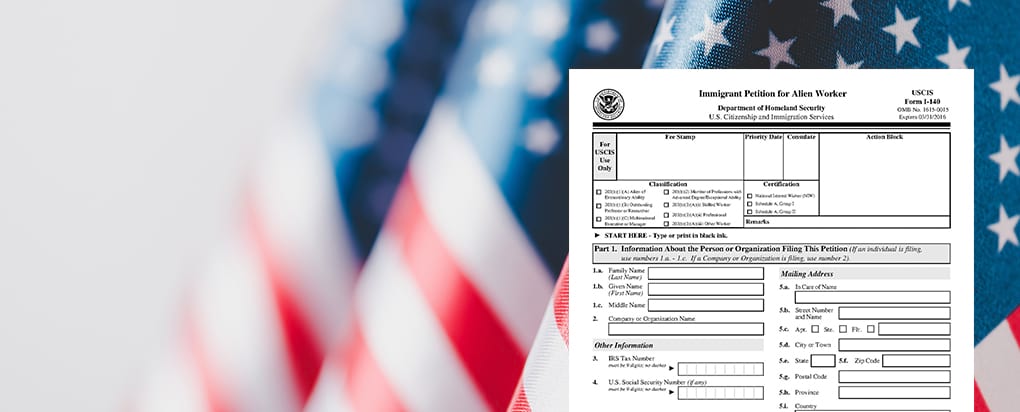
What is I-140 Form and
How to File It
Form I-140 is the Immigrant Petition for Alien Worker who want to obtain an employment-based immigrant visa. This form is used to apply for EB-1, EB-2, or EB-3 visas. The I-140 may also be used to amend an I-140 that has been filed previously.
Who may file I-140 Petition?
In most cases, a U.S. employer files this petition for the alien worker. This requirement applies to applicants of EB-1B professor, EB-1C manager or executive, EB-2 non-NIW (National Interest Waiver), and all EB-3 categories.
The employer is referred to as the petitioner. The potential employee is called the beneficiary.
However, if you are an applicant of EB-1 extraordinary ability or EB-2 NIW, you may file this form yourself.
What documents required for I-140 filing?
The required evidence differs depending on the visa category. Every case is unique. For example,
 |
Most EB-2 and all EB-3 applicants must provide a labor certification from the U.S. Department of Labor; |
 |
All categories, except for EB-1 extraordinary ability and EB-2 NIW, will need to have a legitimate offer for a permanent job from a U.S. employer. |
Some general requirements apply to all cases. For instance, your U.S. employer must prove that it is able to pay the wage that has been offered to you.
Beneficiaries currently living in the U.S. legally will also need to provide a copy of their I-94 Arrival-Departure Record.
The best way to ensure that you have prepared the complete and correct evidence is to talk enlist the counsel of an experienced Immigration Attorney.
What if I need translation and/or interpretation?

If English is not your preferred language, you may use an interpreter to read the questions and instructions in the form to you. The interpreter must complete Part 9 of the form and sign his or her own name.
If you submit any document written in another language, you must also submit a translation of it. The translator must review the translation and sign a certification that the translation is correct. The translator does not have to be a professional but must be able that he or she is competent to translate from the foreign language into English.
How much is the I-140 filing fee?
Currently, the filing fee for the I-140 is $700. However, fees may change from time to time. Check with the USCIS (U.S. Citizenship and Immigration Services) website.
Bank drafts, cashier’s checks, certified checks, personal checks, and money orders that are drawn on U.S. financial institutions and payable in U.S. funds are acceptable forms of payment. Cash is never accepted. The payment should be made payable to “U.S. Department of Homeland Security.” DO NOT use acronyms or abbreviations.
This filing fee is non-refundable and non-returnable, regardless of the outcome of the petition.
Is I-140 Premium Processing Services available and how can I get that?
Premium Processing Services are available for certain categories which may change from time to time. Consult the USCIS website or yimmigration attorney for up-to-date information.
If Premium Processing is available to your case, you may file an I-907 Request for Premium Processing Service application along with your form.

Things that might happen after your I-140 is filed?
I-140 is considered filed once it has been received by the USCIS.
After your I-140 was filed, the USCIS may request
 |
more information or evidence in support of your case. (Experienced Immigration Attorneys will help to ensure that your petition is not unnecessarily delayed because of incomplete or inaccurate documentation.) |
 |
that you appear for interview |
 |
that you appear for a biometric services appointment |
If you have moved after submitting the I-140, you must update your current address with the USCIS within 10 days of your move.
Once your application is approved, you are on the way to immigrating! However, this is only the first step to get a Green Card. The USCIS will provide more information about what you need to do next.
If your application is denied, there may still be other ways to pursue your case. Once again, employing the services of an experienced Immigration Attorney is your best opportunity for ensuring a successful outcome.
The best way to properly file an immigration application and avoid all unnecessary risks or expenses is to always have an expert to help you with it. A qualified Immigration Attorney knows how to do the work efficiently and accurately and to avoid all risks that are not foreseeable to others who are unfamiliar with the U.S. immigration system.
Disclaimer: The article contains general information and does not include legal advice on a particular case.











